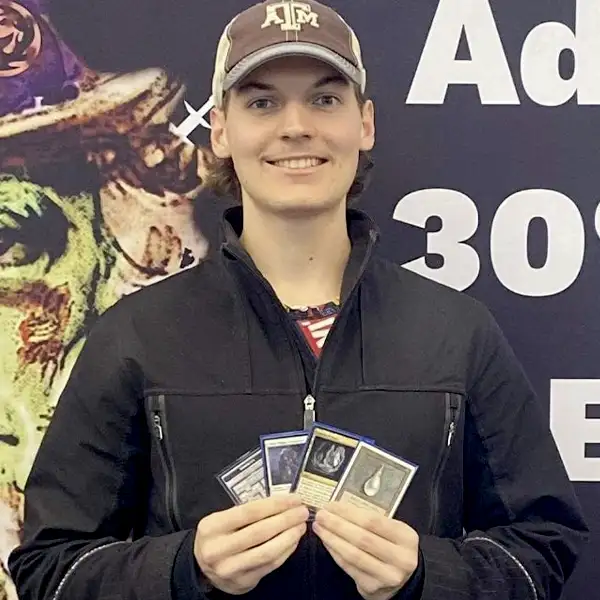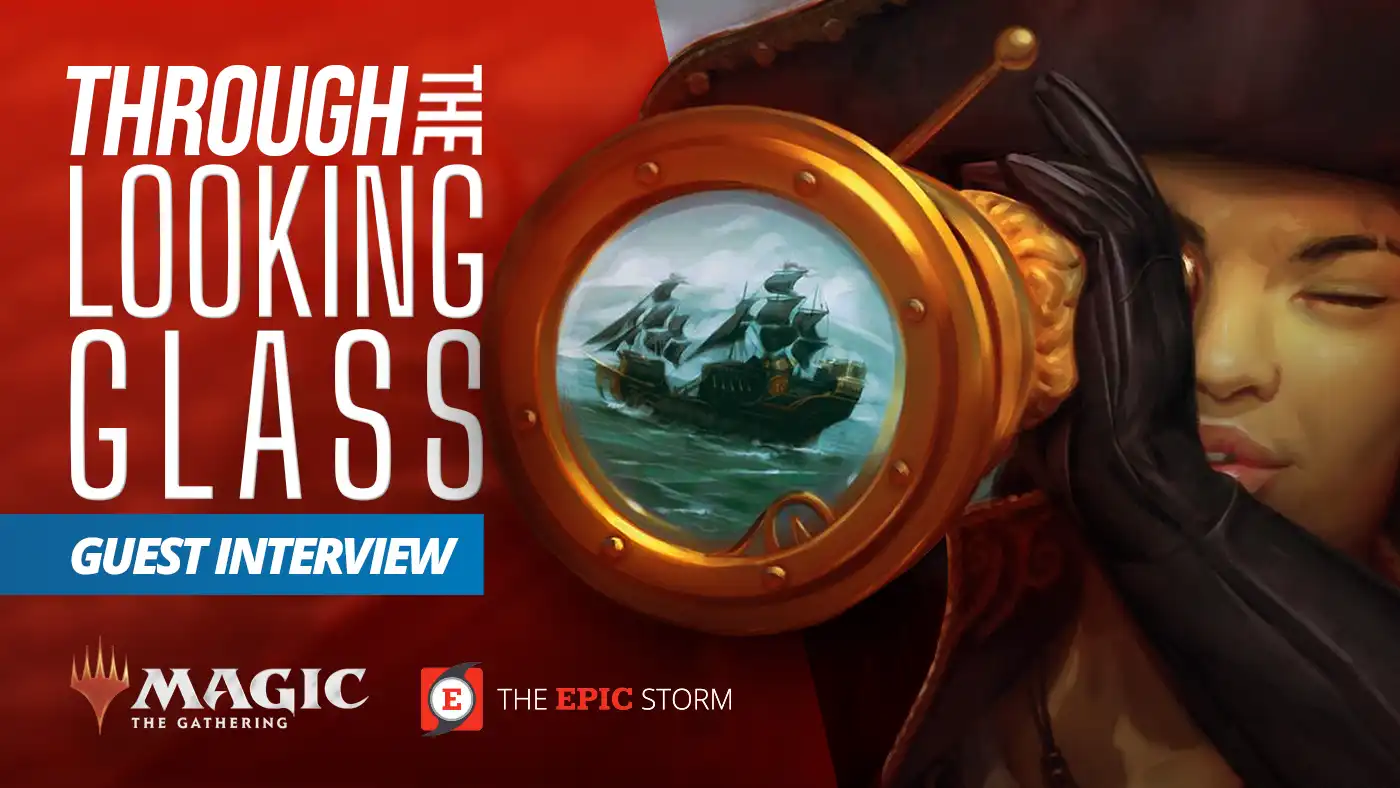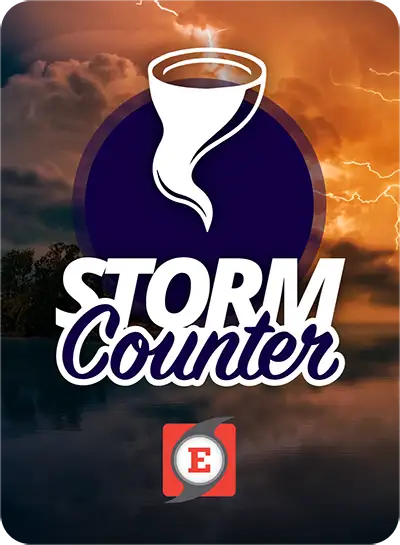
Special Guest
A few words on Lee Webb:
(Twitter: @HanktheObese3 | MTGO: HanktheObese)
Lee Webb (known online as HanktheObese) is an MTGO grinder with expertise across eternal formats ranging from Pioneer to Vintage. He had four Top 32s on Temur Rhinos this past summer (including a Last Chance win in July). Lee is based out of Austin, Texas.
Historically, TES and ANT haven’t had many ways (besides must-counter payoffs like [[Echo of Eons]]) to get ahead on resources as a game progresses, meaning playing draw-go with them and developing our mana doesn’t theoretically hurt us in the same way it might vs., say, Black Saga Storm’s [[Construct Token]]s. [[Mind’s Desire]] changes this calculus a lot, making it much riskier for us to let you sculpt indefinitely.
As soon as I identify that my opponent is on TES, I’m interested in keeping and/or building a hand with a good density of interactive spells and leveraging them well, as opposed to keeping an all-in hand that presents [[Rhino Token]]s early. Obviously we need to eventually present a clock, but I’d be fine keeping something like [[Brazen Borrower]], [[Violent Outburst]], two Force effects and three lands without feeling compelled to mulligan to Spirit Guide effects.
The caveat of “other threat” here is definitely what enabled me to keep so many 7-card hands. I found my mulligan percent on Temur Rhinos to be extremely low, and I was keeping a lot of 7-card hands, but that’s mostly because I didn’t prioritize keeping hands with cascaders. At the end of the day, it’s Legacy – the power level of our opponent’s cards is extremely high, and it’s unlikely that committing two of our cards early in exchange for two 4/4s is going to be more impactful than committing two of our cards early for a [[Force of Will]] on a key spell and relying on the high individual power of our top-decks.
All that said, sometimes a good 7-card hand will be a Force-check on your opponent. If I’m OTP in the dark and I see something like, say, two [[Simian Spirit Guide]] and [[Shardless Agent]] (I think here, [[Shardless Agent]] is better than [[Violent Outburst]] by a decent margin) I’m definitely keeping the hand and just jamming, especially on six cards. Ultimately, I think the real percentage points for this deck come from mulligans, in particular which cards you put back on a keep. This deck has zero library manipulation, so your mulligan decisions will carry with you through the whole game.
You combo gamers are nothing if not consistent! I find the best way to identify a combo opponent is simply by their Goldfish history. I know that’s certainly a ”hack” you can’t leverage in paper, but on MTGO I’ve found (at least, before the unbanning of mind’s desire) that combo “tourists” are pretty rare – you’re either a combo player or you’re not.
In terms of actual cards played, I guess just seeing “non-traditional” lands and play-patterns is a big tip off. The classic example of this, I think, is [[Bloodstained Mire]] into [[Bayou]], [[Volcanic Island]] and / or [[Taiga]]. I know that lists change frequently, but these definitely aren’t evergreen legacy lands you expect to face a lot, and you very rarely see [[Volcanic Island]] fetched off a [[Bloodstained Mire]] in a fair deck. The plays you make can also tip me off – if I see a [[Mishra’s Bauble]] turn one and a non-blue fetchland, followed by a turn-two [[Volcanic Island]] from hand to cast a main-phase [[Brainstorm]], that sort of play-pattern will be indicative of a combo deck more often than not.
Unfortunately, the best threats we have for the matchup are the [[Rhino Token]]s. Obviously [[Brazen Borrower]]’s back side has text, but I find that Borrower typically assumes the role of ”blue card to pitch to [[Force of Will]]” in this matchup.
One of the biggest luck-based factors I’ll call out in the matchup is whether our cascader is [[Shardless Agent]] or [[Violent Outburst]]. With [[Shardless Agent]], you get a beautiful two-turn clock – with [[Violent Outburst]], you don’t – not to mention that it’s not a blue card to pitch to a Force-effect.
This is for sure the strength of the deck. Playing 8 Force-effects is huge, and Rhinos really utilizes them well. If I felt the Legacy meta called for a deck with that much stack-based interaction (at the cost of card advantage) I’d be happy to bring Rhinos to an event again.
Beyond the countermagic package, Rhinos also runs somewhere in the neighborhood of 3-4 copies of [[Endurance]], even main-deck, which can frequently function like an even better [[Force of Will]] in many graveyard-reliant matchups. Additionally, never underestimate [[Brazen Borrower]]’s bounce effect. I’ve found running the card at 4 to be pretty valuable, with it frequently overperforming and representing your best possible top-deck in a lot of spots.
This is a bit of a dance. I find the TES matchup specifically to be very skill-testing and luck-rewarding for this reason. Comparing play patterns against TES to something like ANT for a moment. Generally speaking, ANT casts one spell that wins the game, i.e., [[Ad Nauseam]]. Perhaps [[Beseech the Mirror]] into [[Gaea’s Will]] will end up being the new play pattern, but ultimately their game plan is going to be disrupting our hand, then casting their single spell that wins the game. Against a game plan like this, we need to know what interaction we have access to, and whether it’s relevant (e.g., whether [[Endurance]] will act as another copy of [[Force of Will]], for all intents and purposes) and play accordingly. As a rule of thumb, if I only have one of an effect like this, I’ll always save it for their payoff spell. They won’t always have the [[Thoughtseize]] effect, and they won’t always have it, so I’m inclined to play to the chance that they don’t (even though most Storm piles are constructed to beat a single piece of interaction)
By virtue of [[Galvanic Relay]], these play patterns change quite a bit against TES. In a Legacy Showcase about two months ago I remember being 5-1 and playing against Bryant Cook. While I would consider TES to be a horrible matchup, I had stolen game one off of him, and we were in game three. Bryant cast a [[Rite of Flame]] with no green mana available for [[Veil of Summer]]. I don’t remember exactly how many cards he had left in hand, but in order to play around [[Galvanic Relay]] I decided to deploy my single copy of [[Force of Will]] then. Bryant didn’t end up deploying any payoffs that turn, but I ended up losing the game a few turns later because I didn’t draw an interactive spell for his follow-up play
My takeaway here is that my [[Force of Will]] likely bought me a few extra turns before he was able to go off. From the perspective of the Rhinos player, we have minimal information to go on to tell us what’s in your hand – you might be mana-heavy with a single payoff, or you might be mana-light with multiple payoffs. Perhaps this was a misplay on my end (it certainly went against standard Legacy heuristics for what to counter), or perhaps it looked brilliant. That said, Legacy is changing and we have to change with it!
Lastly, I haven’t tested heavily with [[Lórien Revealed]] and can’t speak to whether it fundamentally changes the deck, but [[Sea Gate Restoration]] has played extremely well for me, and I’m glad I added it to the deck initially (thank the Vintage [[Coveted Jewel]] lists of old for the inspiration, before they cut it!)
Where losing cantrips is toughest is when the land / Spirit Guide count in your opening hand. I find basically every Rhinos hand looks like a mulligan to six, because there’s always one extra card you can’t use yet. An example of this is an opening hand of cascader, [[Force of Will]], blue card, [[Simian Spirit Guide]], and three lands. Land three is superfluous for now (whether we need it or not will depend on what’s on top of our deck), but even without that card this would be a solid six-card hand.
Against TES, the lower I have to mulligan, the more inclined I am to just jam a cascader and hope it’s fast enough. Say I’m on five cards on the draw and my hand is something like, two [[Elvish Spirit Guide]], [[Simian Spirit Guide]], [[Force of Negation]], land, [[Violent Outburst]], [[Shardless Agent]]. My inclination here is to put back the land and the [[Shardless Agent]], fire off the [[Violent Outburst]] on the TES pilot’s upkeep, and just hope to rip a blue card to make our [[Force of Negation]] live as soon as possible. I think this will win a lot more games on five cards, but I think it will also lose a lot more games than keeping a balanced, slower seven.
This is where the ever-changing nature of TES lists can get really tricky. One week, their artifact count is high to enable [[Mox Opal]], so they are playing [[Wishclaw Talisman]], while next week [[Wishclaw Talisman]] might be gone, making it difficult to sideboard effectively. My matchup experience has shown me that [[Force of Vigor]] is rarely worth it, but the card does have text. Even vs. [[Lion’s Eye Diamond]], there can be a window to hit it where it doesn’t make sense to crack in response. If I see a [[Wishclaw Talisman]] game one, I’m more likely to bring in this package.
[[Blood Moon]] isn’t the card I value most highly in my sideboard, but I think it can be a solid plan against ANT and TES, in particular ANT because of their lower artifact mana count.
As for other sideboard hate – most of my tournament results on Rhinos are from events where Reanimator was a big problem, and I was running two copies of [[Inevitable Betrayal]] as an auto-win in that matchup post-board, boarding out [[Crashing Footfalls]]. I could do the same with a card like [[Collector Ouphe]], [[Void Mirror]] or [[Null Rod]] if the meta called for it, but I don’t think it does right now. I’d consider it if the [[Mystic Forge]] decks return in high numbers.
I think that [[Mindbreak Trap]] is a card that’s trying to respect the new [[Mind’s Desire]] and [[Beseech the Mirror]] decks. I think the card is good enough in those matchups to make the change stick. If I were a combo pilot, it’s definitely a card I’d start to play around again.
Short term, no I don’t. I see Temur Rhinos as a deck with a very specific set of threats and answers. I think it’s 100 percent a meta call deck, and I think the deck existing is extremely healthy for the Legacy format. If we enter a meta where the [[Rhino Token]]s supported by eight Force-effects lines up well, the deck will be a good choice, but right now two of the format’s most popular creatures ([[Murktide Regent]] and [[Troll of Khazad-dûm]]) crush Rhinos in combat, so they won’t be the most effective threat in a fair mirror. Meanwhile, I think [[Force of Will]] and [[Force of Negation]] don’t line up well enough with the current combo meta to be worthwhile.
I think it can sometimes be helpful to acknowledge when a matchup is negative or positive to determine how you have to approach it. In my experience, TES has a very positive matchup vs. Temur Rhinos, so if I were the TES pilot, I wouldn’t overly index on the Force-effects – they’re super beatable. I would just lean towards keeping balanced seven-card hands, knowing that you’re going to have at least 2-3 turns to cantrip and sculpt. It’s likely your seven-card hand will be better than mine at the end of it. So, when it’s time to go off, you can easily beat the [[Force of Will]]. I’d say this matchup is pretty unique because there aren’t a lot of decks left that play Force-effects without [[Wasteland]], [[Daze]], [[Spell Pierce]], [[Teferi, Time Raveler]], etc. Basically, execute your gameplan and trust that it’s likely going to be better, even if it’s slow.
I’ve been looking for a spot to mention this because I think it’s really important, especially when playing vs Combo. I take Magic really seriously, I hope not too seriously because this is ultimately just a game, and the relationships formed here will for sure outlive any of the decks, metas, tournaments and wins (and maybe even the cards themselves). That said, I’m definitely the kind of person who can be really hard on myself when I lose. I find the most common feeling I have after playing a really tough midrange or control mirror is “dang, I should have done X, Y, or Z differently.”
When playing against an “unfair” deck – TES, ANT, Black Saga Storm, or anything capable of firing off a turn one kill. It can be easy to salt off after losing. It’s been a mental journey to get to the point where I can recognize that sometimes the combo deck just has it. Sometimes they have the nuts and [[Veil of Summer]] your [[Force of Will]], sometimes they turn one your great hand in the dark because you didn’t have countermagic. Sometimes your lock piece post-board isn’t good enough, or they found their answer, or they had T1 [[Thoughtseize]] and it never mattered. It happens. Tough beats, go next. In Magic (and in life) there’s lessons, and maybe even regrets; sometimes we get punished (and sometimes we don’t!), sometimes I’m angry, sometimes I’m disappointed in myself. But at the end of the day, the headspace I want to be in when I’m sitting across the table from a TES player is knowing that “yeah, they might have it” – tough beats, go next.
I want to give a big shout out to Lee Webb for joining us here at Through the Looking Glass. As a [[Living End]] gamer in Modern, I’m a sucker for seeing cards flip over.
Bang bang Tendrils gang.










